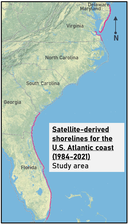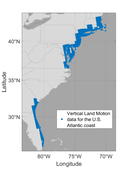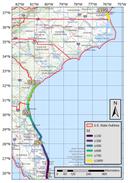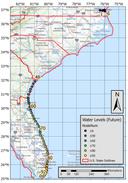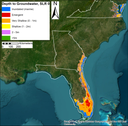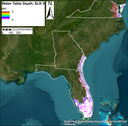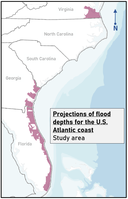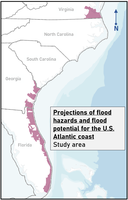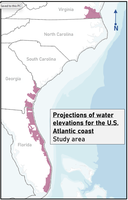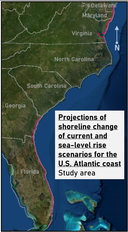Future coastal hazards along the U.S. Atlantic coast
By Patrick L. Barnard, Kevin M. Befus, Jeffrey J Danielson, Anita C. Engelstad, Li H. Erikson, Amy C. Foxgrover, Maya K. Hayden, Daniel J. Hoover, Tim Leijnse, Chris Massey, Robert McCall, Norberto Nadal-Caraballo, Kees M. Nederhoff, Leonard Ohenhen, Andrea O'Neill, Kai A. Parker, Manoocher Shirzaei, Xin Su, Jennifer A. Thomas, Maarten van Ormondt, Sean F. Vitousek, and Madison Yawn
https://doi.org/10.5066/P9BQQTCI
Dates
Published: March 15, 2023
Last Revised: Nov. 22, 2024 (ver. 2.0)
Summary
This product consists of several datasets that map future coastal flooding and erosion hazards due to sea level rise (SLR) and storms for three States (Florida, Georgia, and Virginia) along the Atlantic coast of the United States. The SLR scenarios encompass a plausible range of projections by 2100 based on the best available science and with enough resolution to support a suite of different planning horizons. The storm scenarios are derived with the use of atmospheric drivers from the Coupled Model Intercomparison Project Phase 6 (CMIP6) High Resolution Model Intercomparison Project (HighResMIP), a widely endorsed study that seeks to improve GCM hurricane modeling and applies a systematic approach to investigate the impact of horizontal resolution on simulating climate variables and hurricanes. Downscaled data products provided as part of this data release include: Projected Flood hazards (28 scenarios of 7 SLRs in combination with 3 storms and daily conditions), storm surge and astronomic tide time-series within the nearshore region for projected future storms (2020-2050), shoreline change time-series (2020-2100); depth to water table (7 SLR scenarios); and vertical land motion (14 years of historical observations).
Satellite Data
-
Satellite-derived shorelines for the U.S. Atlantic coast (1984-2021)
This dataset contains shoreline positions derived from available Landsat satellite imagery for five states (Delaware, Maryland, Viginia, Georgia, and Florida) along the U.S. Atlantic coast for the time period 1984 to 2021. An open-source toolbox, CoastSat (Vos and others, 2019a and 2019b), was used to classify coastal Landsat imagery and detect shorelines at the sub-pixel scale. Resulting shorelines are presented in KMZ format. Significant uncertainty is associated with the locations of shorelines in extremely dynamic regions, including at the locations of river mouths, tidal inlets, capes, and ends of spits. These data are readily viewable in Google Earth. For best display of results, it is recommended to turn off any 3D viewing. For technical users and researchers, data can be ingested into Global Mapper or QGIS for more detailed analysis. Similar shoreline positions for North Carolina and South Carolina are available from Barnard and others, 2023 at https://doi.org/10.5066/P9W91314.
Data Files
SatelliteDerivedShorelines_FL.kmz - 96.9 MB
SatelliteDerivedShorelines_GA.kmz - 32.6 MB
SatelliteDerivedShorelines_VA_MD_DE.kmz - 32.7 MB
Metadata Files
SatelliteDerivedShorelines_metadata.xml - 29.2 KB
SatelliteDerivedShorelines_metadata.txt - 27.8 KB
-
Vertical land motion rates for the years 2007 to 2020 for the U.S. Atlantic coast
This dataset contains rates of land subsidence and uplift derived from Sentinel-1A/B (2015-2020) and ALOS (2007-2011) synthetic aperture radar (SAR) satellites, at approximately 50-75 m resolution and mm-level precision for the U.S. Atlantic coast except for the states of North and South Carolina. The data consist of vertical land motion (VLM) rates and the 1-sigma error in land motion rates and are available as csv files. Similar vertical land motion rates for North Carolina and South Carolina are available from Barnard and others, 2023, at https://doi.org/10.5066/P9W91314.
Data Files
VerticalLandMotion_Rate_CT.zip - 21.8 MB
VerticalLandMotion_Rate_DE.zip - 8.8 MB
VerticalLandMotion_Rate_FL.zip - 43.6 MB
VerticalLandMotion_Rate_GA.zip - 27.7 MB
VerticalLandMotion_Rate_MA.zip - 33.3 MB
VerticalLandMotion_Rate_MD.zip - 25.1 MB
VerticalLandMotion_Rate_NH.zip - 2.5 MB
VerticalLandMotion_Rate_NJ.zip - 41.8 MB
VerticalLandMotion_Rate_NY.zip - 21.5 MB
VerticalLandMotion_Rate_RI.zip - 3.3 MB
VerticalLandMotion_Rate_VA.zip - 11.7 MB
Metadata Files
VerticalLandMotion_Rate_metadata.xml - 35.0 KB
VerticalLandMotion_Rate_metadata.txt - 33.3 KB
Simulation Data
-
Nearshore parametric wave setup future projections (2020-2050) for the U.S. Atlantic coast
This dataset presents alongshore wave setup timeseries for three states (Virginia, Georgia, and Florida) along the U.S. Atlantic coast. Wave setup was modelled using parameterization for open coast sandy beaches as presented in Stockdon and others (2006). The parameterization relates onshore wave setup to offshore wave conditions and beach characteristics. Wave conditions were extracted at approximately the 10 m depth contour and reverse shoaled to the deep-water condition. These data were then matched to cross-shore transects spaced at approximately 1 km along the coastline. Beach slope at these transects were extracted from lidar (Doran and others, 2017) and temporally averaged across all available datasets. Waves were modelled using a global WAVEWATCHIII model forced by atmospheric forcing from the Coupled Model Intercomparison Project (CMIP6) future period data. Data are provided for 6 CMIP6 models from the HighResMIP project (Haarsma and others, 2016). Output includes 1-hour wave setup provided at approximately 1,600 alongshore transects at approximately 1-5 km resolution. Data are available as csv files for each transect location and are bundled by state. The methodology used to produce this dataset is further detailed in Parker and others (2023) and similar modelled data for North Carolina and South Carolina are available from Barnard and others, 2023, at https://doi.org/10.5066/P9W91314.
Data Files
WaveSetup_CMIP6Fut_FL.zip - 1.9 GB
WaveSetup_CMIP6Fut_GA.zip - 465.3 MB
WaveSetup_CMIP6Fut_VA.zip - 150.5 MB
WaveSetup_Ref_TransectIdsLocs_FL.csv - 24.2 KB
WaveSetup_Ref_TransectIdsLocs_GA.csv - 6.4 KB
WaveSetup_Ref_TransectIdsLocs_VA.csv - 1.9 KB
Metadata Files
WaveSetup_CMIP6Fut_metadata.xml - 35.3 KB
WaveSetup_CMIP6Fut_metadata.txt - 34.0 KB
-
Nearshore parametric wave setup hindcast data (1979-2019) for the U.S. Atlantic coast
This dataset presents alongshore wave setup timeseries for three states (Virginia, Georgia, and Florida) along the U.S. Atlantic coast. Wave setup was modelled using parameterization for open coast sandy beaches as presented in Stockdon and others (2006). The parameterization relates onshore wave setup to offshore wave conditions and beach characteristics. Wave conditions were extracted at approximately the 10 m depth contour and reverse shoaled to the deep-water condition. These data were then matched to cross-shore transects spaced at approximately 1 km along the coastline. Beach slope at these transects were extracted from lidar (Doran and others, 2017) and temporally averaged across all available datasets. The hindcast model is forced by waves taken directly from the ERA5 reanalysis, which incorporates observations and data assimilation (Hersbach and others, 2020). Modeled wave setup time series are presented for the hindcast period 1979 to 2019. Output includes 1-hour wave setup provided at approximately 1,600 alongshore transects at approximately 1-5 km resolution. Data are available as csv files for each transect location and are bundled by state. This dataset and the methodology used for its production is further detailed in Parker and others (2023) and similar modelled data for North Carolina and South Carolina are available from Barnard and others, 2023, at https://doi.org/10.5066/P9W91314).
Data Files
WaveSetup_ERA5_FL.zip - 897.8 MB
WaveSetup_ERA5_GA.zip - 216.9 MB
WaveSetup_ERA5_VA.zip - 67.6 MB
WaveSetup_Ref_TransectIdsLocs_FL.zip - 7.2 KB
WaveSetup_Ref_TransectIdsLocs_GA.zip - 2.1 KB
WaveSetup_Ref_TransectIdsLocs_VA.zip - 808 bytes
Metadata Files
WaveSetup_ERA5_metadata.xml - 34.4 KB
WaveSetup_ERA5_metadata.txt - 33.0 KB
-
Nearshore water level, tide, and non-tidal residual future projections (2016-2050) for the U.S. Atlantic coast
A dataset of modeled nearshore water levels (WLs) was developed for three states (Virginia, Georgia, and Florida) along the U.S. Atlantic coast. Water levels, defined for this dataset as the linear sum of tides and non-tidal residuals (NTR), were produced by Muis and others (2016) using a global tide and surge model (GTSM) forced by global atmospheric fields. Water level outputs were extracted from the global grid at approximately 20 km resolution along the Atlantic coastline. These data were then statistically downscaled using a signal-specific set of corrections to improve skill in comparison to tide gauge observations (Parker and others, 2023). Projected water levels were forced by CMIP6 future period data. Four CMIP6 climate models were selected from the High-Resolution Model Intercomparison project (highresMIP; Haarsma and others, 2016) to sample variability in climate predictions. Similar modeled data for North Carolina and South Carolina are available from Barnard and others, 2023, at https://doi.org/10.5066/P9W91314)
Data Files
WL_Tide_NTR_CMIP6Fut_FL.zip - 1.8 GB
WL_Tide_NTR_CMIP6Fut_GA.zip - 361.3 MB
WL_Tide_NTR_CMIP6Fut_VA.zip - 286.5 MB
WL_Tide_NTR_CMIP6_Ref_StationIdsLocs_FL.csv - 758 bytes
WL_Tide_NTR_CMIP6_Ref_StationIdsLocs_GA.csv - 170 bytes
WL_Tide_NTR_CMIP6_Ref_StationIdsLocs_VA.csv - 146 bytes
Metadata Files
WL_Tide_NTR_CMIP6Fut_metadata.xml - 38.3 KB
WL_Tide_NTR_CMIP6Fut_metadata.txt - 37.0 KB
-
Nearshore water level, tide, and non-tidal residual hindcasts (1979-2016) for the U.S. Atlantic coast
A dataset of modeled nearshore water levels (WLs) was developed for three states (Virginia, Georgia, and Florida) along the U.S. Atlantic coast. Water levels, defined for this dataset as the linear sum of tides and non-tidal residuals (NTR), were produced by Muis and others (2016) using a global tide and surge model (GTSM) forced by global atmospheric fields -. Water level outputs were extracted from the global grid at approximately 20 km resolution along the coastlines. These data were then statistically downscaled using a signal-specific set of corrections to improve skill in comparison to tide gauge observations (Parker and others, 2023). Hindcast water levels were forced by ERA5 atmospheric forcing provided by the dataset of Hersbach and others (2020). ERA5 is a reanalysis product, incorporating observations and data assimilation to best represent the experienced climate. Therefore, data from this version of the dataset are comparable to observed WLs along the study region. Similar modeled data for North Carolina and South Carolina are available from Barnard and others, 2023, at https://doi.org/10.5066/P9W91314)
Data Files
WL_Tide_NTR_ERA5hindc_FL.zip - 667.3 MB
WL_Tide_NTR_ERA5hindc_GA.zip - 138.1 MB
WL_Tide_NTR_ERA5hindc_VA.zip - 92.2 MB
WL_Tide_NTR_ERA5_Ref_StationIdsLocs_FL.csv - 789 bytes
WL_Tide_NTR_ERA5_Ref_StationIdsLocs_GA.csv - 182 bytes
WL_Tide_NTR_ERA5_Ref_StationIdsLocs_VA.csv - 134 bytes
Metadata Files
WL_Tide_NTR_ERA5hindc_metadata.xml - 35.2 KB
WL_Tide_NTR_ERA5hindc_metadata.txt - 33.7 KB
-
Projected groundwater emergence and shoaling along the Virginia, Georgia, and Florida coasts
Groundwater emergence and shoaling extents are derived from water table depth GeoTIFFs, which are calculated as steady-state groundwater model heads subtracted from high-resolution topographic digital elevation model (DEM) land surface elevations. Results are provided as shapefiles of water table depth in specific depth ranges. Similar modeled data for North Carolina and South Carolina are available from Barnard and others, 2023 at https://doi.org/10.5066/P9W91314.
Data Files
GWHazards_EmergShoaling_FL_Kx0p1_WTbins.zip - 393.1 MB
GWHazards_EmergShoaling_FL_Kx10_WTbins.zip - 354.3 MB
GWHazards_EmergShoaling_FL_Kx1_WTbins.zip - 401.0 MB
GWHazards_EmergShoaling_GA_Kx0p1_WTbins.zip - 110.8 MB
GWHazards_EmergShoaling_GA_Kx10_WTbins.zip - 85.4 MB
GWHazards_EmergShoaling_GA_Kx1_WTbins.zip - 108.7 MB
GWHazards_EmergShoaling_VA_Kx0p1_WTbins.zip - 527.0 MB
GWHazards_EmergShoaling_VA_Kx10_WTbins.zip - 265.7 MB
GWHazards_EmergShoaling_VA_Kx1_WTbins.zip - 422.8 MB
Metadata Files
-
Projected groundwater head along the Virginia, Georgia, and Florida coasts
Seamless unconfined groundwater heads for U.S. coastal Virginia, Georgia, and Florida (Atlantic and Gulf coast south of Sarasota) groundwater systems were modeled with homogeneous, steady-state MODFLOW simulations. The geographic extent examined was limited primarily to low-elevation (land surface less than approximately 10 m above mean sea level) areas. Steady-state MODFLOW groundwater flow models were used to obtain detailed (50-meter-scale) predictions over large geographic scales (100s of kilometers) of groundwater heads for both current and future sea-level rise (SLR) scenarios (0, 0.25, 0.5, 1, 1.5, 2, 2.5, and 3 m) using 3 spatially varying hydraulic conductivities (K); one based on published K's, one with published K's reduced by a factor of 10 (K*0.1), and one with published K's increased by a factor of 10 (K*10) to assess the sensitivity of model results to K. All models had variable thicknesses corresponding to published transmissivities. The models were run with a local mean higher-high water (MHHW) marine boundary condition and with groundwater reaching the land surface removed from the model, simulating loss via natural drainage. Similar modeled data for North Carolina and South Carolina are available from Barnard and others, 2023 at https://doi.org/10.5066/P9W91314.
Data Files
GWHazards_GWHead_FL_Kx0p1.zip - 1.6 GB
GWHazards_GWHead_FL_Kx10.zip - 1.6 GB
GWHazards_GWHead_FL_Kx1.zip - 1.6 GB
GWHazards_GWHead_GA_Kx0p1.zip - 294.0 MB
GWHazards_GWHead_GA_Kx10.zip - 291.3 MB
GWHazards_GWHead_GA_Kx1.zip - 293.1 MB
GWHazards_GWHead_VA_Kx0p1.zip - 507.4 MB
GWHazards_GWHead_VA_Kx10.zip - 503.8 MB
GWHazards_GWHead_VA_Kx1.zip - 506.8 MB
Metadata Files
GWHazards_GWHead_metadata_VA_GA_FL.xml - 28.8 KB
GWHazards_GWHead_metadata_VA_GA_FL.txt - 27.5 KB
-
Projected water table depths along the Virginia, Georgia, and Florida coasts
To predict water table depths, seamless groundwater heads for unconfined coastal Virginia, Georgia, and Florida (Atlantic and Gulf coast south of Sarasota) groundwater systems were modeled with homogeneous, steady-state MODFLOW simulations. The geographic extent examined was limited primarily to low-elevation (land surface less than approximately 10 m above mean sea level) areas. Steady-state MODFLOW groundwater flow models were used to obtain detailed (50-meter-scale) predictions over large geographic scales (100s of kilometers) of groundwater heads for both current and future sea-level rise (SLR) scenarios (0, 0.25, 0.5, 1, 1.5, 2, 2.5, and 3 m) using 3 spatially varying hydraulic conductivities (K); one based on published K's, one with published K's reduced by a factor of 10 (K*0.1), and one with published K's increased by a factor of 10 (K*10) to assess the sensitivity of model results to K. All models had variable thicknesses corresponding to published transmissivities. The models were run with a local mean higher-high water (MHHW) marine boundary condition, and with groundwater reaching the land surface removed from the model, simulating loss via natural drainage. Modeled groundwater heads were then subtracted from high-resolution topographic digital elevation model (DEM) data to obtain the water table depths. Similar modeled data for North Carolina and South Carolina are available from Barnard and others, 2023, at https://doi.org/10.5066/P9W91314.
Data Files
FL_Kzell0p1_slr0p00m_10m_wt_depth.tif - 5.5 GB
FL_Kzell0p1_slr0p25m_10m_wt_depth.tif - 5.5 GB
FL_Kzell0p1_slr0p50m_10m_wt_depth.tif - 5.4 GB
FL_Kzell0p1_slr1p00m_10m_wt_depth.tif - 5.4 GB
FL_Kzell0p1_slr1p50m_10m_wt_depth.tif - 5.4 GB
FL_Kzell0p1_slr2p00m_10m_wt_depth.tif - 5.4 GB
FL_Kzell0p1_slr2p50m_10m_wt_depth.tif - 5.3 GB
FL_Kzell0p1_slr3p00m_10m_wt_depth.tif - 5.3 GB
FL_Kzell10_slr0p00m_10m_wt_depth.tif - 5.5 GB
FL_Kzell10_slr0p25m_10m_wt_depth.tif - 5.5 GB
FL_Kzell10_slr0p50m_10m_wt_depth.tif - 5.5 GB
FL_Kzell10_slr1p00m_10m_wt_depth.tif - 5.5 GB
FL_Kzell10_slr1p50m_10m_wt_depth.tif - 5.5 GB
FL_Kzell10_slr2p00m_10m_wt_depth.tif - 5.5 GB
FL_Kzell10_slr2p50m_10m_wt_depth.tif - 5.4 GB
FL_Kzell10_slr3p00m_10m_wt_depth.tif - 5.4 GB
FL_Kzell1_slr0p00m_10m_wt_depth.tif - 5.5 GB
FL_Kzell1_slr0p25m_10m_wt_depth.tif - 5.5 GB
FL_Kzell1_slr0p50m_10m_wt_depth.tif - 5.5 GB
FL_Kzell1_slr1p00m_10m_wt_depth.tif - 5.5 GB
FL_Kzell1_slr1p50m_10m_wt_depth.tif - 5.4 GB
FL_Kzell1_slr2p00m_10m_wt_depth.tif - 5.5 GB
FL_Kzell1_slr2p50m_10m_wt_depth.tif - 5.4 GB
FL_Kzell1_slr3p00m_10m_wt_depth.tif - 5.4 GB
GWHazards_WaterTableDepth_GA_SLR0p25.zip - 3.0 GB
GWHazards_WaterTableDepth_GA_SLR0p5.zip - 3.0 GB
GWHazards_WaterTableDepth_GA_SLR0.zip - 3.0 GB
GWHazards_WaterTableDepth_GA_SLR1p0.zip - 2.9 GB
GWHazards_WaterTableDepth_GA_SLR1p5.zip - 2.9 GB
GWHazards_WaterTableDepth_GA_SLR2p0.zip - 2.9 GB
GWHazards_WaterTableDepth_GA_SLR2p5.zip - 2.9 GB
GWHazards_WaterTableDepth_GA_SLR3p0.zip - 2.9 GB
GWHazards_WaterTableDepth_VA_SLR0p25.zip - 4.8 GB
GWHazards_WaterTableDepth_VA_SLR0p5.zip - 4.8 GB
GWHazards_WaterTableDepth_VA_SLR0.zip - 4.8 GB
GWHazards_WaterTableDepth_VA_SLR1p0.zip - 4.8 GB
GWHazards_WaterTableDepth_VA_SLR1p5.zip - 4.8 GB
GWHazards_WaterTableDepth_VA_SLR2p0.zip - 4.8 GB
GWHazards_WaterTableDepth_VA_SLR2p5.zip - 4.8 GB
GWHazards_WaterTableDepth_VA_SLR3p0.zip - 4.8 GB
Metadata Files
-
Projections of coastal flood depths for the U.S. Atlantic coast
Projected depths from compound coastal flood hazards for future sea-level rise (SLR) and storm scenarios are shown for the U.S. Atlantic coast for three states (Florida, Georgia, and Virginia). Projections were made using a system of numerical models driven by output from Global Climate Models (GCMs) from the Coupled Model Intercomparison Project Phase 6 (CMIP6) and a tropical cyclone database from U.S. Army Corp of Engineers. The resulting data are depths of projected flood hazards along the U.S. Atlantic coast due to sea-level rise and plausible future storm conditions that consider the changing climate, hurricanes, and natural variability. The resulting data products include flood depths that are consistent with coastal flood projections, also available in this dataset (Barnard, and others, 2023); see Nederhoff and others (2024) for a full explanation of data and methods. In addition to sea-level rise, flood simulations run by these numerical models included dynamic contributions from tide, storm surge, wind, waves, river discharge, precipitation, and seasonal sea-level fluctuations. Outputs include impacts from combinations of SLR scenarios (0, 0.25, 0.5, 1.0, 1.5, 2.0, and 3.0 m), storm conditions including 1-year, 20-year, and 100-year return interval storms, and a background condition (no storm - astronomic tide and average atmospheric conditions). Similar projections for North Carolina and South Carolina are available from Barnard and others, 2023, at https://doi.org/10.5066/P9W91314
Data Files
Projections_WaterDepth_FL.zip - 3.8 GB
Projections_WaterDepth_GA.zip - 1.6 GB
Projections_WaterDepth_VA.zip - 967.3 MB
Metadata Files
Projections_WaterDepths_AtlanticCoast_metadata.xml - 66.7 KB
Projections_WaterDepths_AtlanticCoast_metadata.txt - 63.7 KB
-
Projections of coastal flood hazards and flood potential for the U.S. Atlantic coast
Projected impacts by compound coastal flood hazards for future sea-level rise (SLR) and storm scenarios are shown for the U.S. Atlantic coast for three states (Florida, Georgia, and southern Virginia). Accompanying uncertainty for each SLR and storm scenario, indicating total uncertainty from model processes and contributing datasets, are illustrated in maximum and minimum flood potential. As described by Nederhoff and others (2024), projections were made using a system of numerical models driven by output from Global Climate Models (GCMs) from the Coupled Model Intercomparison Project Phase 6 (CMIP6) and a tropical cyclone database from US Army Corp of Engineers. The resulting data products include detailed flood-hazard maps along the U.S. Atlantic coast due to sea-level rise and plausible future storm conditions that consider the changing climate, hurricanes, and natural variability. In addition to sea-level rise, flood simulations run by these numerical models included dynamic contributions from tide, storm surge, wind, waves, river discharge, precipitation, and seasonal sea-level fluctuations. Outputs include impacts from combinations of SLR scenarios (0, 0.25, 0.5, 1.0, 1.5, 2.0, and 3.0 m) storm conditions including 1-year, 20-year and 100-year return interval storms and a background condition (no storm - astronomic tide and average atmospheric conditions). See Nederhoff and others (2024) for a full explanation of data and methods. Similar projections for North Carolina and South Carolina are available from Barnard and others, 2023, at https://doi.org/10.5066/P9W91314.
Data Files
FloodHaz_Areas_Not_Mapped_FL.zip - 146.1 KB
FloodHaz_Areas_Not_Mapped_GA.zip - 533.8 KB
FloodHaz_ModelOutput_Boundary_FL.zip - 234.9 KB
FloodHaz_ModelOutput_Boundary_GA.zip - 639.5 KB
FloodHaz_ModelOutput_Boundary_VA.zip - 46.2 KB
Projections_FloodHazard_FL.zip - 585.3 MB
Projections_FloodHazard_GA.zip - 205.9 MB
Projections_FloodHazard_VA.zip - 164.9 MB
Metadata Files
Projections_FloodHazards_AtlanticCoast_metadata.xml - 69.8 KB
Projections_FloodHazards_AtlanticCoast_metadata.txt - 66.6 KB
-
Projections of coastal flood water elevations for the U.S. Atlantic coast
Projected water elevations from compound coastal flood hazards for future sea-level rise (SLR) and storm scenarios are shown for the U.S. Atlantic coast for three states (Florida, Georgia, and Virginia). Projections were made using a system of numerical models driven by output from Global Climate Models (GCMs) from the Coupled Model Intercomparison Project Phase 6 (CMIP6) and a tropical cyclone database from U.S. Army Corps of Engineers. The resulting data are water elevations of projected flood hazards along the U.S. Atlantic coast due to sea-level rise and plausible future storm conditions that consider the changing climate, hurricanes, and natural variability. The resulting data products include water elevations that are consistent with coastal flood projections, also available in this dataset (Barnard, and others, 2023); see Nederhoff and others (2024) for a full explanation of data and methods. In addition to sea-level rise, flood simulations run by these numerical models included dynamic contributions from tide, storm surge, wind, waves, river discharge, precipitation, and seasonal sea-level fluctuations. Outputs include impacts from combinations of SLR scenarios (0, 0.25, 0.5, 1.0, 1.5, 2.0, and 3.0 m), storm conditions including 1-year, 20-year, and 100-year return interval storms, and a background condition (no storm - astronomic tide and average atmospheric conditions). Similar projections for North Carolina and South Carolina are available from Barnard and others, 2023, at https://doi.org/10.5066/P9W91314
Data Files
Projections_WaterElevation_FL.zip - 1.0 GB
Projections_WaterElevation_GA.zip - 403.5 MB
Projections_WaterElevation_VA.zip - 267.7 MB
Metadata Files
Projections_WaterElevation_AtlanticCoast_metadata.xml - 66.2 KB
Projections_WaterElevation_AtlanticCoast_metadata.txt - 63.2 KB
-
Projections of shoreline change of current and future (2005-2100) sea-level rise scenarios for the U.S. Atlantic Coast
This dataset contains projections of shoreline change and uncertainty bands for future scenarios of sea-level rise (SLR). Scenarios include 25, 50, 75, 100, 150, 200, and 300 centimeters (cm) of SLR by the year 2100. Output for SLR of 0 cm is also included, reflective of conditions in 2005, in accordance with recent SLR projections and guidance from the National Oceanic and Atmospheric Administration (NOAA; see process steps).Projections were made using the Coastal Storm Modeling System - Coastal One-line Assimilated Simulation Tool (CoSMoS-COAST), a numerical model (described in Vitousek and others, 2017; 2021; 2023) run in an ensemble forced with global-to-local nested wave models and assimilated with satellite-derived shoreline (SDS) observations. Shoreline positions from models are generated at pre-determined cross-shore transects and output includes different cases covering important model behaviors (cases are described in process steps of metadata; see citations listed in the Cross References section for more details on the methodology and supporting information). This model shows change in shoreline positions along transects, considering sea level, wave conditions, along-shore/cross-shore sediment transport, long-term trends due to sediment supply, and estimated variability due to unresolved processes (as described in Vitousek and others, 2021). Variability associated with complex coastal processes (for example, beach cusps/undulations and shore-attached sandbars) are included via a noise parameter in a model, which is tuned using observations of shoreline change at each transect and run in an ensemble of 200 simulations; this approach allows for a representation of statistical variability in a model that is assimilated with sequences of noisy observations. The model synthesizes and improves upon numerous, well-established shoreline models in the scientific literature; processes and methods are described in this metadata (see lineage and process steps), but also described in more detail in Vitousek and others 2017, 2021, and 2023. KMZ data are readily viewable in Google Earth. For best display of results, it is recommended to turn off any 3D features or terrain. For technical users and researchers, shapefile and KMZ data can be ingested into geographic information system (GIS) software such as Global Mapper or QGIS.
Data Files
ShorelineChange_projctn_DE.zip - 17.9 MB
ShorelineChange_projctn_FL.zip - 258.5 MB
ShorelineChange_projctn_GA.zip - 58.4 MB
ShorelineChange_projctn_MD.zip - 22.8 MB
ShorelineChange_projctn_VA.zip - 68.1 MB
Metadata Files
ShorelineChange_projctn_AtlanticCoast_metadata.xml - 62.5 KB
ShorelineChange_projctn_AtlanticCoast_metadata.txt - 60.9 KB
Suggested Citation
Barnard, P.L., Befus, K., Danielson, J.J., Engelstad, A.C., Erikson, L.H., Foxgrover, A.C., Hayden, M.K., Hoover, D.J., Leijnse, T., Massey, C., McCall, R., Nadal-Caraballo, N., Nederhoff, K., Ohenhen, L., O'Neill, A., Parker, K.A., Shirzaei, M., Su, X., Thomas, J.A., van Ormondt, M., Vitousek, S.F., Vos, K., Yawn, M.C., 2023, Future coastal hazards along the U.S. Atlantic coast (ver. 2.0, November 2024): U.S. Geological Survey data release, https://doi.org/10.5066/P9BQQTCI.
Revision History
First release: 2023
Revised: November 2024 (ver. 2.0)
Changes in Version 2.0
New dataset added for rasters of water surface elevation derived from existing flood depth data

